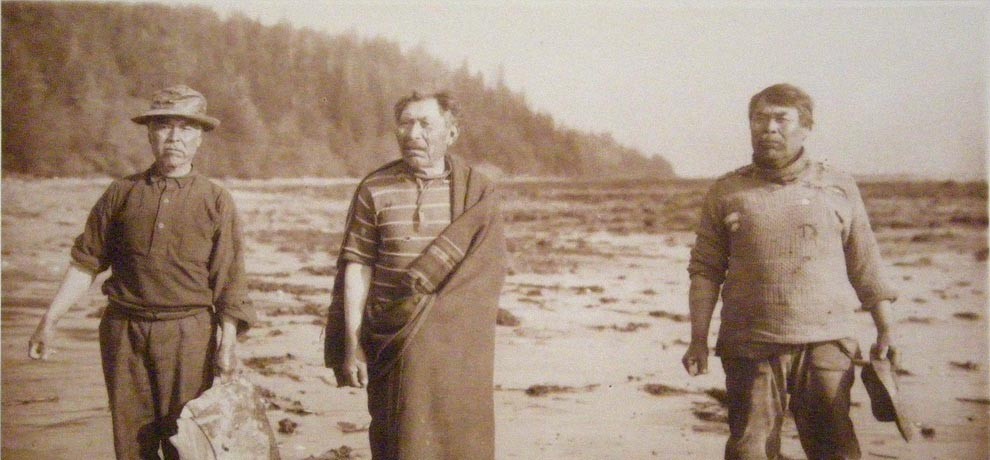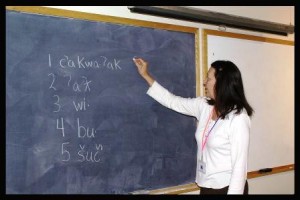Makah Language Programs Preserves Our Culture
The Makah Language Program conducts research, documentation analysis, curriculum development, and teaching of the Makah Language to the Neah Bay Elementary and High School. An Elementary Makah Language Dictionary is forthcoming.
Makah Language Program (MLP) Goals
The goals of the program are as follows:
1. To preserve the Makah Language
2. To restore the Makah Language to spoken fluency
3. To educate our children and people as scholars, able to compete anywhere in today’s world and yet maintain their Tribal heritage
Makah Language Program Funding
Funding for the MLP is provided by the Administration for Native Americans, Makah Cultural and Research Center and the Makah Tribal Council.
Qʷi·qʷi·diččaqʔiq The Makah Language
Description
Qʷi·qʷidiččaq ‘Makah Language’ or ‘speaking Makah’ belongs to the Wakashan language family, specifically Southern Wakashan and is the ancestral language of the Makah Tribe in Neah Bay, Washington. Our language is related to the languages spoken by Ditidaht, Pacheedaht and Nuu-chah-nulth First Nations located on the west coast of Vancouver Island, B.C., Canada. As noted in the Makah Museum’s exhibit leaflet (1979/1995) we are culturally and linguistically related, and continue to value and maintain our connections.
The Makah Tribal Council (MTC) enacted Resolution #120-93 to make the Makah Language the official language of the Tribe (MLP files, 1993). Qʷi·qʷi·diččaq (Makah) is our official language.
Regarding the Makah orthography and vocabulary, “In 1978 our Makah Language Program (MLP) was officially formed. Our Qʷi·qʷi·diččaq writing system is an adaptation of the International Phonetic Alphabet and North American Phonetic Alphabet spelling systems; the letters and symbols were agreed upon by a core of Makah Elder speakers” (Pascua, 2020, p. 3). Our language is described as having a verb, subject, object sequence, or beginning with the predicate, although there are exceptions; the main function is that the language builds by having a lead word. Our language is polysynthetic and consists of many word parts.
The Makah Alphabet Chart below lists the Makah letter, specific letter and diacritic names, phonetic-like spelling, and familiar English words for pronunciation examples.
Makah Alphabet Chart
Consonants
| ʔ | glottal stop, no sound but a catch in the throat as in the pause between the syllables in uh-uh. | ƛ | barred-lambda; juicy [kl] or [tl]
click sound in the side of the mouth. |
| c | [ts] as in hats or tsunami | x | |x| is made by rasping air in the roof of the mouth like air escaping from a tire or the Spanish sounds in Jose and Mexico. |
| č | [ch] as in chin | x̌ | x-wedge made by rasping air friction near the back of the throat like a sawing noise. |
| š | [sh] as in shell | q | |q| is a low k-sound, made by raising the root of the tongue towards the back of the throat. |
| ɫ | barred-l, lisped or juicy l-sound made in the side of the mouth by blowing air while tongue is in position to say an [l]-sound. |
|
Diacritics
| ʷ | raised-w, round the lips while producing the sound the raised-w accompanies. | ’ | glottal mark, make the sound by constricting, popping or sharpening the sound the glottal marked letter. |
Vowels
| Short | Long | Combined | ||||
| a | uh as in mutt | a· | ah as in hot | ay | ī Hawai’i | |
| aw | as in ouch | |||||
| e | ě as in bet | e· | ă as in cat | ey | ā as in Hey! | |
| i | ĭ as in sit | i· | ē as in feet | iy | iy honey | |
| iw | as in few | |||||
| o | ô as in fôr | o· | ō as in note | oy | oy as in toy | |
| u | oo as in lŏŏk | u· | o͞o as in moon | uy | uy (said quickly) | |
Occasional Letters – There are some sounds occurring in names, songs and Chinook Jargon as well: m and n (pronounced the same as English), ŋ as in song, and ḥ or dotted-h causing the ‘h’ breath sound to be made further back near the throat opening.
Stress or Accented Syllable – If the first syllable vowel is short, stress the second syllable. If the first syllable vowel is long (has a dotted vowel), then stress the first syllable. EXAMPLE: ʔaƛpu· seven, č̓i·x̌pa·ɫ six.
Unicode Keyboard Set Up for Word Processing in Qʷi·qʷi·diččaq
To download:
Go to http://www.languagegeek.com/ . Go to KEYBOARDS then scroll down to WAKASHAN. Click Qʷi·qʷi·diččaq. Click MACK Download or WINDOWS as needed for your operating system.
For WINDOWS the download looks like this: MS_Wakashan35.zip, begin downloading
Open the download and go to Windows Keyboards (or it may say Windows Keyboard Layout). Click on the Qʷi·qʷi·diččaq Keyboard. Save the file to your desktop or location of your choice.
Open the new download (Keyboard Layout sub folder) and double click SET UP. Wait for the installation to complete, and then close the window. ; to change keyboards, toggle to Qʷi·qʷi·diččaq – Makah (or ENG US English [United States] Qᵂi·qʷi·diččaq – Makah keyboard). Note: the wedges over the |c|’s do not show in this icon label. Return to English by toggling the icon back to US (or Eng US,English [United States] US keyboard).
If the icon does not appear, re-boot your computer and then check for the KEYBOARD icon. If it still does not appear, click – Start Button, click – Control Panel, click – Clock and World Calendar, select Change the Keyboard, click – ADD and check mark – qʷi·qʷi·diččaq
Word Processing Using the Qᵂi·qʷi·diččaq Keyboard
When word processing in Qʷi·qʷi·diččaq, click FILE, scroll down to OPTIONS, click PROOFING, click AUTOCORRECT, unclick all of the CORRECT and CAPITALIZE buttons so the boxes are ‘deselected’ or show no check marks.
To word process , use the number keys and other functions as explained below:
ʷ (raised-w) press 2
š (s-wedge) press 3
č (c-wedge) press 4
ƛ (barred-lambda) press 5
ŋ (ng sound) press 6
x̌ (x-wedge) press 7
ɫ (barred-l) press 8
ʔ (glottal stop) press 9
° (signal marker) press 0
- (dot for vowel length) press the colon :
‘ (glottal mark to pop sounds) press the apostrophe/quotation key ‘/”
Period, comma and explanation mark are the same keys as when word processing in English. If you need to use other numbers or symbols simply toggle the keyboard icon back to US (United States – English), or hold down cntrl + alt (or cntrl + alt + shift, see keyboard layout on the languagegeek website).
References
Harvey, Chris/Languagegeek, (2002-2009). Wakashan Qʷi·qʷi·diččaq (Makah). Languagegeek.
https://www.languagegeek.com/keyboard_general/all_keyboards.html
Makah Language Program, (files). Resolution #120-93 Makah Language, Official Language of the Makah Tribe. Neah Bay, WA: Makah Cultural & Research Center.
Makah Tribal Council, (1995). Makah Cultural and Research Center: Museum exhibit leaflet. Neah Bay, WA: Makah Tribal Council. (Original work published in 1979).
Pascua, Maria, (2020). Using Qʷi·qʷi·diččaq ‘Makah’ in our community: A dialogue approach for adult learners (Unpublished master’s project). Victoria, B.C., Canada: University of Victoria.



